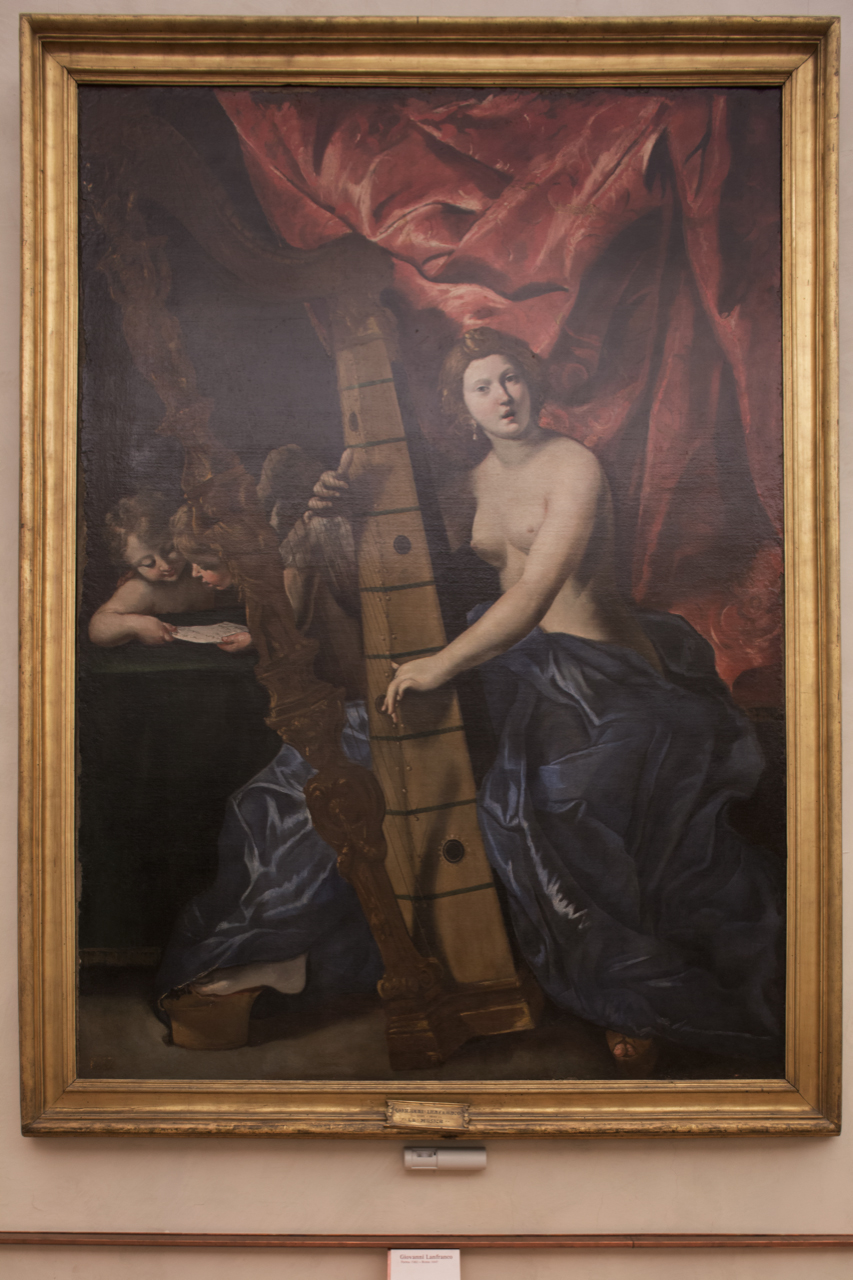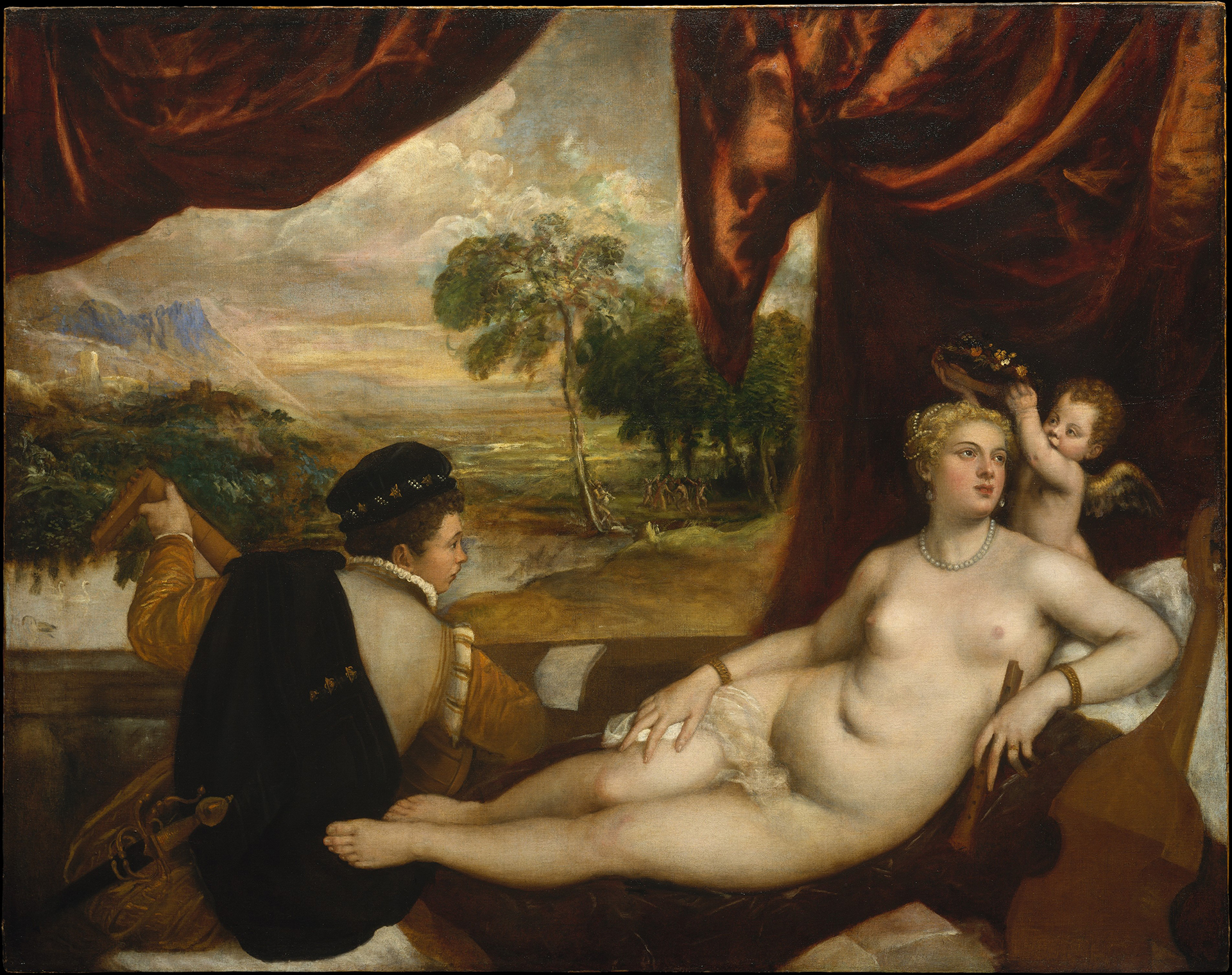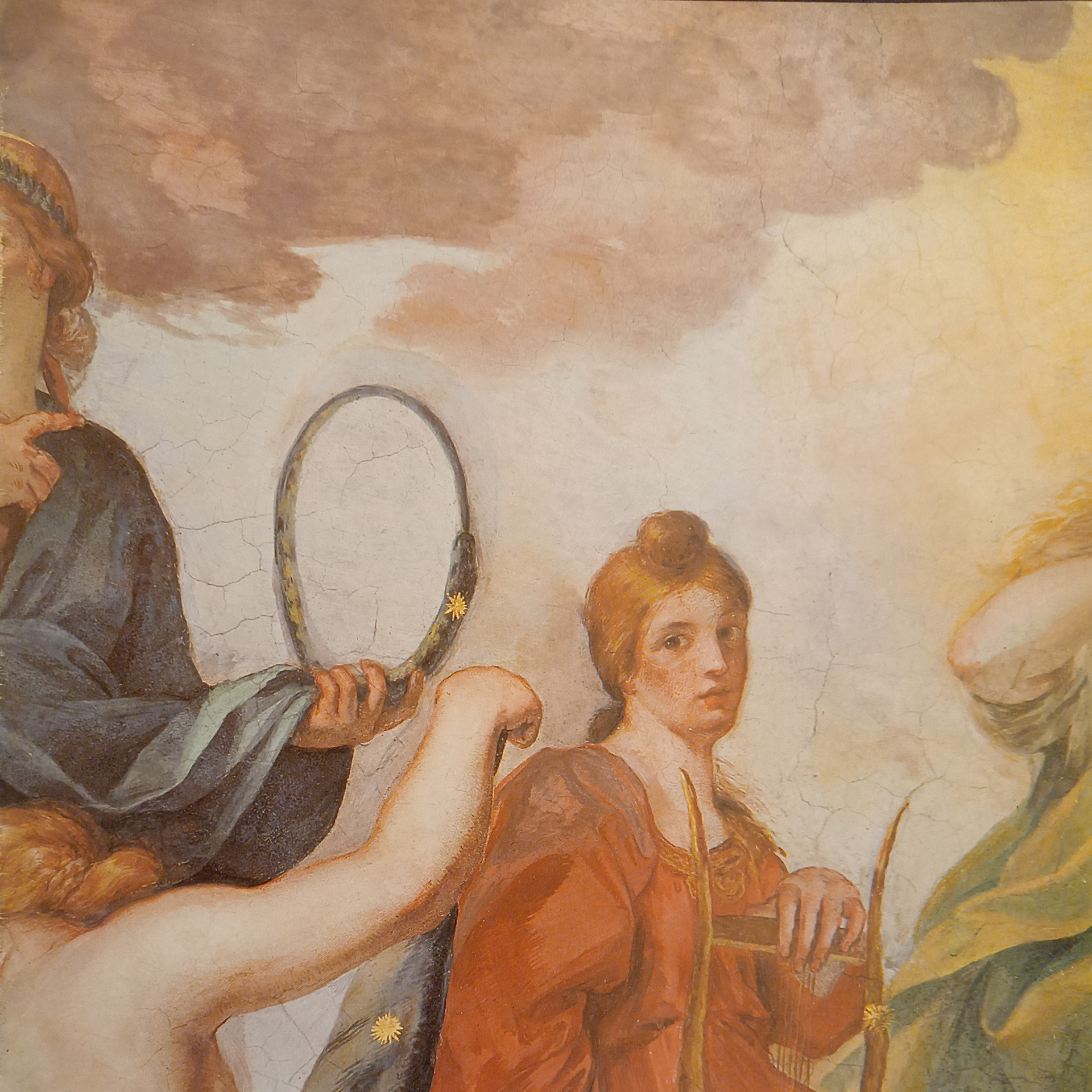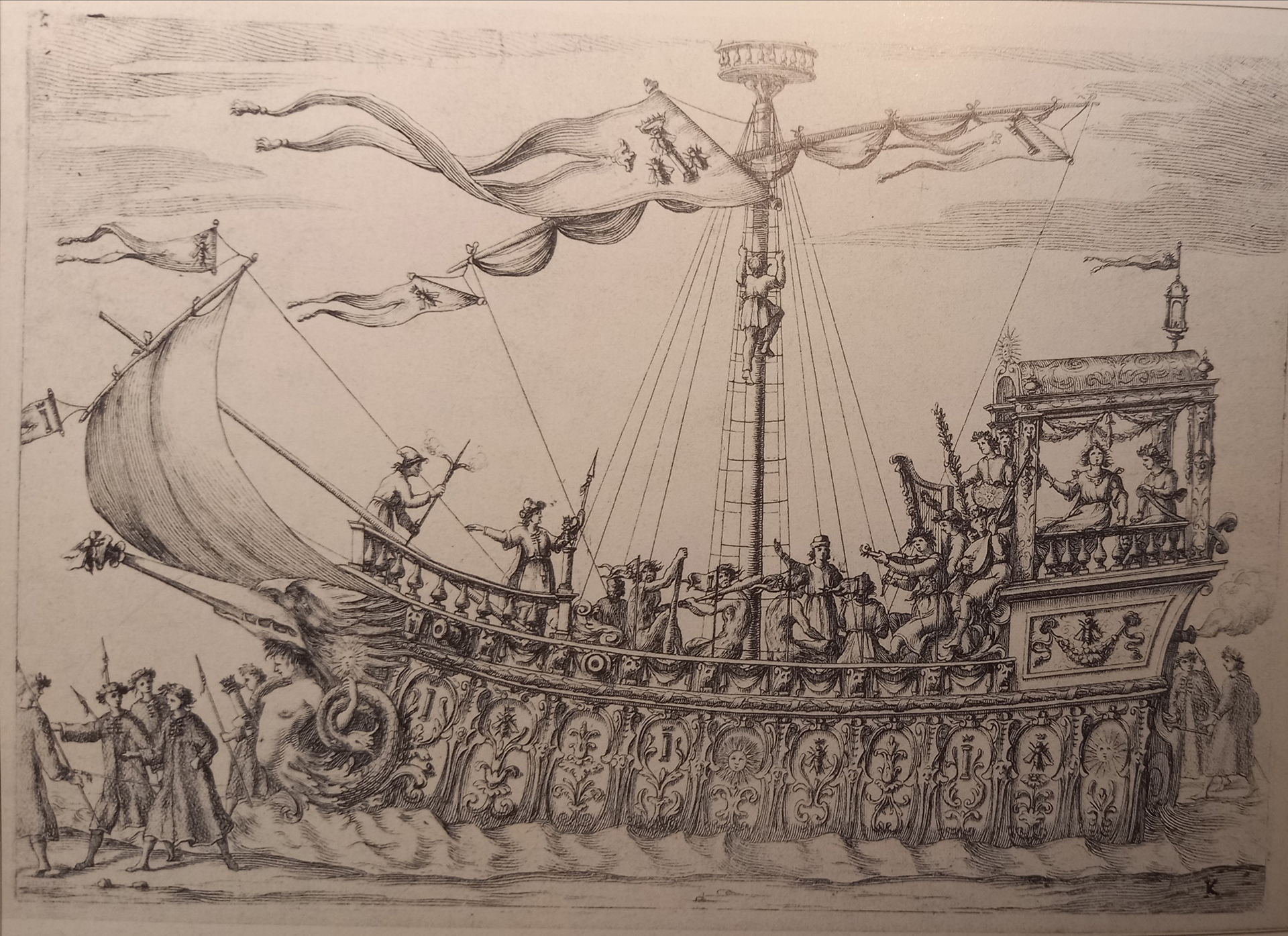Link to the original version of this article in Italian: “Venere che sona d’arpa e due amori”: Marco Marazzoli alla corte dei Barberini
DOI: 10.5281/zenodo.7762635

Giovanni Lanfranco, Venere che suona l’arpa (Fig. 1 ).
This article focuses on a painting by Giovanni Lanfranco that is today on display at the Galleria Nazionale d’Arte Antica di Palazzo Barberini,1 depicting a harp very similar to the one usually referred to as the Barberini Harp,2 today at the Museo Nazionale degli Strumenti Musicali in Roma.

The Barberini Harp at the Museo Nazionale degli Strumenti Musicali (Fig. 2 ).
It had long been thought that the Barberini family commissioned the painter Giovanni Lanfranco to produce the painting, until it was discovered that it had in fact been bequeathed to Antonio Barberini by the famous harpist, composer and singer Marco Marazzoli.3 This article intends to provide insights into the painting with particular regard to the representation of the harp, and to offer a more precise consideration as to when this painting was created. Later, we intend to analyse the painting inside Marazzoli’s home by relating it to other paintings exhibited there.
1) The painting and Marazzoli
The humanist Sabba Castiglione writes in his Ricordi, published in 1575, about musical instruments adorning the homes of many people, as “quali ornamenti io certo commendo assai perché questi tali istrumenti dilettano molto all’orecchio, e ricreano molto gli animi, i quali come diceva Platone, si ricordano dell’armonia la qual nasce da i moti delli circoli celesti: ancora piacciono assai a l’occhio, quando sono diligentemente e per mano d’eccellenti maestri lavorati.”4 The importance of a musical instrument as an object not only to be played but also to be looked at gains strength in the following century, to the extent that the famous theorist Giovanni Battista Doni writes in his treatise on scenic music: “Facendosi dunque apparire gli strumenti alla vista del popolo è convenevole aver riguardo che abbiano bella e graziosa apparenza […] perché un’arpa indorata fa bellissima vista e il suo suono si sente e meglio si unisce alla voce umana; e insomma ha più del grande e del nobile che gli strumenti da tasti […].”5 And it is, perhaps, the fact of instruments being represented in paintings (and what paintings if we consider the one owned by Marazzoli!) that makes the importance of the aesthetics of these objects plainer yet. Lanfranco’s painting depicts a woman enveloped up to her waist in ample, voluminous blue cloth. She is playing a double harp, its column carved and gilded, her face turned to the viewer in the act of singing. To her right two winged cupids join her in singing, reading from a sheet of music, while a large red brocade cloth on her left backgrounds the scene. The subject of the painting itself is interesting. What is it about?
Before Franca Trinchieri Camiz recognised it as mentioned in Marazzoli’s will,6 the painting was considered as an allegory of music and known as, simply, “la musica.”7 Marazzoli, the first owner of the painting, describes it as “Venere che sona d’arpa e due Amori.”8 The identification with Venus, the goddess of love, is demonstrated only by two cupids in the background, as the woman depicted has no attributes that would characterise her as Venus. The iconography of Venus as a musician is certainly unusual. Even as it is true that depictions of the goddess connect her with music, for example, in Tiziano’s Venus and a musician paintings, she is rarely represented in the act of playing.

Tiziano, Venere e il suonatore di liuto (Fig. 3 ).
It is worth noting that Marazzoli’s Venus loses its connotation the moment it enters the Barberini collections, where it was inventoried from 1671 simply as a “donna grande al naturale che suona l’Arpa mezza nuda mano del Cav. Lanfranco.”9 The painting could be in relation to the representations of Venetian women (often courtesans), particularly in vogue in the 1600s, depicted playing an instrument, usually a lute. They often assumed characteristics of Venus, goddess of love, by virtue of the erotic character of the image. Just like in the Venetian paintings, the woman is lifelike; her hairstyle is fashioned in the way we find in other works from the early 1630s.

Andrea Sacchi, Allegoria della Divina Sapienza, detail (Fig. 4 ).
The clogs, often worn by courtesans, and the earrings are both elements contributing to the sensuous character of the figure. This is also true of the depiction of musical activity, as music has been since antiquity considered capable of arousing strong emotions, especially if interpreted by a woman.10
It is the subject matter, but also the theatricality of the composition that make this painting stand out: with red cloth evoking a curtain, harp in the foreground, the woman’s gaze is turned to the viewer as if performing her music exclusively for him. Most conspicuous is the predominance of the instrument that is very similar to the Barberini Harp.11 The presence of this instrument on the canvas is justified precisely because the painting belonged to Marazzoli, the famous harpist. Not only was he the owner of the painting, but the harp depicted in it was in his possession, even if it actually belonged to his patron Cardinal Antonio Barberini. The latter’s inventory of 1636-1644 mentions, in fact, “un’Arpa grande tutta intagliata dorata con sue corde in mano a Marco Marazzoli,”12 which later reappears in the last will and inventory of the musician. Some documents in the Archivio Barberini also attest that Antonio Barberini had commissioned a harp for Marazzoli in 1632-1633, and paid a total of around 125 scudi for it.13 Among these documents there is also a tool description provided by the carver that coincides with the carving work on the harp depicted by Lanfranco. One can imagine that this important and expensive instrument, made especially for the harpist, provided the inspiration for the painting, which would have probably been painted between 1633—when the harp was made—and 1634—when Lanfranco left Roma. This appears even clearer once we consider the leading role the harp assumes in the painting, represented theatrically as if bursting towards the viewer, angled so as to bring the carved column clearly into view.
2) The painting inside Marazzoli’s home
Marazzoli’s relationship with the Barberini family began shortly after his arrival in Roma from Parma, his hometown, in 1626, probably following Cardinal Ippolito Aldobrandini.14 The earliest documents attesting to his service at the Barberini court date back to 1629 and concern harp maintenance costs.15 Indeed, he must have been known as a harpist, given that he was referred to in documents as “Marco dell’arpa.” His rise within the Barberini circle and at the papal court is attested in his role of bussolante16 conferred on him by the pope—Urbano VIII Barberini—in 1634. That same year he took part in the music performance at the Giostra del Saracino, a knightly tournament; Marazzoli can perhaps be identified as the harpist depicted on the ship of Bacchus.

François Colignon after Andrea Sacchi, La nave di Bacco (Fig. 5 ).
In addition, Marazzoli had a number of roles in his service to Antonio Barberini, Urbano VIII’s nephew. Marazzoli is documented in 1637 as “aiutante di camera,” a year later among the virtuosos of the family, and from 1639 as a “musico.” The same year he joined the Cappella pontificia as a “cantore soprannumerario,"17 to become a full member in 1640. And it was precisely at the end of the 1630s that Marazzoli began composing music for theatrical works for the Barberini. This work was interrupted by the death of Urbano VIII in 1644 and the consequent departure of his nephews for France, only to resume upon their return to Roma in 1653, the year of the Barberini’s reconciliation with papa Innocenzo X.18 Marazzoli’s bond with the Barberini persisted until his death in Roma in 1662.
From reading the inventory drawn up on Marazzoli’s death, we learn that he lived in via Felice, today’s via Sistina, near the church of Santa Francesca Romana, which was demolished in the mid-twentieth century. In “uno stanziolino dell’appartamento nobile a mano manca nell’entrare verso il cortile” there was “un’arpa grande senza corde, dorata, in una cassa coperta di corame rosso con l’arme dell’Em. Sig. Card. Antonio.”19 Presumably this is the harp depicted in the painting made for Marazzoli, and returned by him to the cardinal after his death.20 This little room must have been intended for musical instruments, as in it we also find another ordinary harp (also belonging to Cardinal Antonio Barberini) and a Spanish guitar. The inventory also lists two other boxes containing various musical strings, a desk and a book “with various notes and accounts.” Given the room’s scarce furnishings it was presumably where the instruments were kept. From there a corridor led to the “room of the first apartment.” Reading the inventory seems to suggest this to have been a reception room, richly furnished.21 It is here that we find “un cimbalo a due registri colorito di noce e filo d’oro […], varii specchi, teste scultoree, due portiere, di cui una di corame turchino e oro e l’altra di panno verde foderata di tela sangalla,”22 and several paintings, almost all of profane subjects (with the exception of one depicting Mary Magdalene and a drawing of the Assumption). Among these paintings we find two by Lanfranco that Marazzoli had bequeathed to members of the Barberini family. Those are “l’Erminia tra i pastori,”23 destined for Carlo Barberini, and “Cleopatra,” left to Maffeo Barberini, the Prince of Palestrina. However, the “Venere che suona d’Arpa” is not on display, which is curious considering that it must have been one of the most prestigious paintings in his collection, and that in this room it would have been in an ideal context among a harpsichord and a multitude of profane subjects. Considering the presence of the harpsichord and this room’s proximity to the one housing musical instruments, it is conceivable that this was a room in which Marazzoli met with others to make music. Furthermore, the fact that the harp was Marazzoli’s instrument would be another reason for exhibiting the painting in an important room of his home, where he could show off and appropriately represent himself as a musician.
Instead, the painting hangs in a room that is accessed after passing through two corridors and which is described as “contiguous with the main room.”24 This room is adorned with red and yellow silk, its door decorated with brocade in the same colours. Its ambiance draws character from the presence of a walnut wardrobe, an ebony study with ivory trim and six floral tapestry chairs. A mirror and various paintings of different subjects—sacred and profane—cover the walls, with pieces of silverware, a “moro intagliato in legno che porta in capo una conchiglia di legno dorato”25 and a large bronze crucifix completing the furnishings. Two paintings by Marco Marazzoli are to be found among the paintings hanging on the walls, which suggests that he, like other musicians linked to court environments, dabbled in painting.26 These two paintings, “Icaro con cornice dorata” and “Didone […] con cornice brunita e dorata”27 are the only ones listed in the inventory as being made by Marazzoli. Lanfranco’s Venere can be found displayed right next to Marazzoli’s Didone, following precisely the order of the inventory. And this is interesting, because it is as if Marazzoli had assembled in the same room those works that refer to both his pictorial and musical activity, even though he was primarily a musician and not a painter. Apparently, he betrayed no discomfort in showing his paintings next to those by such a successful painter as Lanfranco. This points to the topic of “amateurism” that developed within the court environments among both the nobles and the courtiers. This legacy of the past required of a “gentleman” to be at ease in various artistic (and other) disciplines, as described by Baldassare Castiglione in Il Cortegiano.28 Without delving deeper into the topic, this suggests that the arts were close to each other, and consequently how easily intertwined were the lives of artists and persons of various backgrounds.
The relationship between Marazzoli and Lanfranco can be traced back to the first period in which they were both in Roma, between 1626, the year of Marazzoli’s arrival, and 1634, the year of Lanfranco’s departure for Napoli. Both from Parma, they found themselves in Roma, in the orbit gravitating around the Barberini. It is likely that the three paintings listed in Marazzoli’s will (precisely Venere, Cleopatra and Erminia) were also painted in that period. We don’t know if the relationship between Lanfranco and Marazzoli was also that of a master and his student. We do know, however, from Giovanni Battista Passeri’s Vite de’ pittori, that Lanfranco’s daughter “suonava assai bene l’arpa doppia e che cantava comodamente,”29 suggesting a hypothesis that Marazzoli gave music lessons in Lanfranco’s home. Perhaps it was that by hanging Didone, a painting by his own hand, next to Lanfranco’s painting, the subject of which and the presence of the harp suit Marazzoli more than any other, Marazzoli was also referring to the friendship that existed between them.
Let us turn to the inventory one last time and note a detail that may escape us at first but which, in our opinion, is not devoid of meaning. In the room described above there are, in addition to the paintings by Marazzoli and that of Lanfranco, two landscapes and some depicting sacred subjects, including “Una Madonna di palmi quattro e tre larga con un Cristo, Un Angelo e S. Caterina con quattro Api alle Cantonate e cornice rabescata con cordoni dorati.”30 The frame reveals the importance of the painting: arabesque decorated, it is distinguished from other frames by golden cords.31 Most interesting, however, is the presence of the four bees, suggesting this was a gift from the Barberini family, perhaps as reward for a service rendered.32 We can deduce from this painting, just as with Venere che suona l’arpa, something about the importance of Marazzoli’s relationship with his patrons. In fact, returning to Lanfranco’s painting, given the importance of the instrument—demonstrated by its carvings, dimensions, Cardinal Antonio’s coat of arms above the column—it is conceivable that anyone who knew Marazzoli would easily have seen references in the painting to the Barberini, great patrons of music. It is significant that on Marazzoli’s death this painting will be left to Cardinal Antonio Barberini: “Item lascio al S. Card. Antonio un Quadro grande originale del Cav.r Lanfranchi con la sua Cornice nera e oro. È una Venere che sona d’Arpa e due Amori.“33 Two other paintings by Lanfranco, already mentioned, were left to Carlo Barberini and Maffeo Barberini. More paintings were left to Giulio Rospigliosi, Carlo Pio di Savoia, and Orazio Magalotti. Here too it is clear that they belonged to a well-defined circle of people around the Barberini. Rospigliosi, future Papa Clemente IX, wrote librettos for musical dramas presented by the Barberini, while Magalotti was related to the pope’s family through the marriage of his cousin, Costanza Magalotti, to Carlo Barberini, the pope’s brother.
In conclusion, Lanfranco’s painting appears as a tribute to Marazzoli and his qualities as a musician through the representation of a very precious instrument, built specifically for him as one of the most distinguished harp virtuosos of his time. The painting obviously also pays homage to the Barberini as Marazzoli’s patrons, but also as patrons of important musical events in which, according to the words of Giovanni Battista Doni, the instruments were made to “appear to the people” and had to have a “beautiful and gracious presence,” especially the harp that “has more greatness and nobility.”34 The environment and furnishings in which the painting is exhibited in Marazzoli’s home are therefore also significant as they clearly signal his belonging to the court environment. In this room he presents himself and represents his microcosm: the music, of course, to which he owes his success, but, as we have seen, also painting, understood as the activity of a gentleman used to the court environment and the presence of princes and cardinals, in particular that of his patrons, the Barberini.
Bibliography
Barb.lat. 4209. Archivio Barberini, Biblioteca Apostolica Vaticana. Città del Vaticano.
Bruno, Silvia. “Musici e pittori tra Firenze e Roma nel secondo quarto del Seicento.” Studi Secenteschi 49 (2008): 204.
Calenne, Luca and Maria Cristina Paciello. “Pittor de’ gli orecchi è Rodomonte. Ricerche su Domenico Palombi, Musico e Pittore del ‘600.” Annali della Pontificia Insigne Accademia di Belle Arti e Lettere dei Virtuosi al Pantheon 12 (2012): 241–264, 449–463.
Castiglione, Sabba. Ricordi, overo Ammaestramenti. Venezia, 1575.
Daolmi, Davide. “L’armi e gli amori”. Un’opera di cappa e spada nella Roma di mezzo Seicento.” PhD diss., Università degli studi di Roma “La Sapienza”, 2001. http://www.examenapium.it/armi/marazzoli.pdf.
Doni, Giovanni Battista. Lyra Barberina amphicordos. De’ trattati di musica, vol. 2. Firenze, 1763.
Databases. Getty Provenance Index. The Getty Research Institute. https://www.getty.edu/research/tools/provenance/search.html.
Granata, Chiara. “‘Un’arpa grande tutta intagliata e dorata’. New documents on the Barberini harp.” Recercare 27, 1/2 (2015): 139–164. https://www.jstor.org/stable/26381197.
Haiduk, Marina. In Wege des Barock. Die Nationalgalerien Barberini Corsini in Rom, edited by Ortrud Westheider and Michael Philipp. München, London, New York: Prestel, 2019.
Hess, Jakob ed. Die Künstlerbiographien des Giovanni Battista Passeri. Nach den Handschriften des Autors. Leipzig: Keller, 1934.
Lionnet, Jean. “Andrè Maugars: risposta data a un curioso sul sentimento della musica in Italia." Nuova rivista musicale italiana 19, 4 (1985): 691, note 12.
Marazzoli, Marco. Oratorio di Santa Caterina. In Reliquie di Roma II: Caro sposo. Atalante (ensemble), Erin Headley (director). Destino Classics/Nimbus Alliance NI 6185, 2012. CD.
Mochi Onori, Lorenza and Rossella Vodret Adamo. Galleria Nazionale d’Arte Antica – Palazzo Barberini – I dipinti. Catalogo sistematico. Roma: L’Erma di Bretschneider, 2008.
Mochi Onori, Lorenza and Rossela Vodret Adamo. La Galleria Nazionale d’Arte Antica, Regesto delle didascalie. Roma: Palombi, 1989.
Morelli, Arnaldo. “Carlo Rainaldi musicista gentiluomo. Una riconsiderazione e qualche novità." In La festa delle arti. Scritti in onore di Marcello Fagiolo per cinquant’anni di studi, edited by Vincenzo Cazzato, Sebastiano Roberto, Mario Bevilacqua, 432–435. Roma: Gangemi, 2001.
Morelli, Arnaldo. “Marco Marazzoli (ad vocem)." In Dizionario Biografico degli Italiani, edited by Alberto M. Ghisalberti, vol. 69, 466–471. Roma: Istituto della Enciclopedia Italiana, 2007.
Notai segretari e cancellieri della Reverenda Camera Apostolica, vol. 2082. Archivio di Stato di Roma.
Simi Bonini, Eleonora. “Uno strumento e la sua storia: l’arpa Barberini," Nuova rivista musicale italiana XLVI (2012): 205–226.
Speck, Christian. Das italienische Oratorium, 1625–1665: Musik und Dichtung. Turnhout: Brepols, 2003.
Tezi, Girolamo. Aedes Barberinae ad Quirinalem descriptae, edited by Lucia Faedo. Pisa: Ed. della Normale, 2005.
Trinchieri Camiz, Franca. “Una Venere, un’Erminia, una Cleopatra di Giovanni Lanfranco in un documento inedito." Bollettino d’arte 67 (1991): 165–168.
Ziane, Alexandra. “Santa o cortigiana? La figura della donna musicista dopo i suonatori di liuto di Caravaggio." In La musica al tempo di Caravaggio, edited by Stefania Macioce and Enrico de Pascale, 149–164. Roma: Gangemi, 2012.
Cite:&&Elisabetta Frullini, “'Venere che sona d’arpa e due amori': Marco Marazzoli at the Barberini Court," Harfenlabor.com, May 18, 2022, https://harfenlabor.com/research/venere-che-sona-d-arpa-e-due-amori-marco-marazzoli-at-the-barberini-court/.
